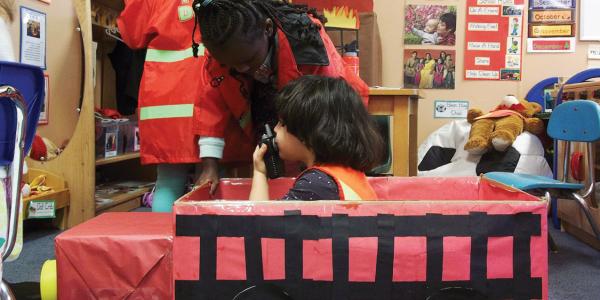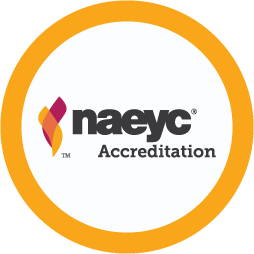Talking with Parents about Play and Learning

You are here
The beginning of the school year is a great time to help preschoolers’ families understand the connections between play and their children’s learning and development.
Parents rarely question the role of play in their infants’ and toddlers’ learning. But as young children enter preschool, a shift takes place. Parents seem to start doubting the learning aspects of play. They look instead to “academics”—direct instruction, workbooks, and children sitting still in the classroom.
We can help families understand why play is critical for preschoolers’ learning and development—and how play sets children up for future school success. We also need to let families know that teachers intentionally design play activities with specific learning goals in mind.
Daily opportunities for children to learn through play are engaging, essential, and meaningful!
When you describe play and learning, help families understand unfamiliar words and terms. Try to avoid complicated vocabulary.
Learning and development: Skills, knowledge, and what children can do and understand
Cognitive skills
Play helps children develop cognitive skills—thought processes of learning. These include remembering, problem solving, making decisions, processing information, and learning language.
During play, children develop foundational understanding in math, science, and social studies. Here are some examples.
Math: When children are shoppers or cashiers in a pretend grocery store, or when they build in the block area, they use numbers (“It costs three cents”), explore measurement (“My tower is taller than yours”), and develop problem-solving abilities (“Put the big blocks on the bottom so your wall won’t fall down”).
Science: Children use science concepts like prediction when they experiment at the sand and water table. (“I think two scoops of sand will fill the bucket.”)
Social studies: As children take on different roles in the dramatic play area, they practice being parents (“It’s bedtime. Let’s put on your pajamas and we’ll read a book.”) and learn about community helpers, like health care professionals (“Put your arm here so I can take an X-ray”) and postal workers (“I have a package for you in my truck”).
Language and literacy
Children develop early reading, vocabulary, and writing skills by telling familiar stories to stuffed animals (“Once upon a time, there were three bears”), using the names of different dinosaurs as they play with figures (“The brontosaurus ate all the leaves on that tree!”), and creating a menu for an imaginary restaurant (“Write pizza first—it starts with P”).
Social skills
During play, children learn to interact with others. They talk, collaborate, and pretend together. They might be workers in a veterinarian’s office (“Let’s put the dog on the scale.”), shoppers at a farmers’ market (“Can you help me? I need to buy an apple.”), or workers on a street repair crew (“Can I hold the stop sign while you and Denise fix the potholes?”).
Emotional skills
Children are beginning to recognize and talk about emotions. As they play in different scenarios—a birthday party (“I’m really excited about blowing out the candles.”) or a doctor visit (“Will I get a shot? I feel scared.”)—they are able to relax, focus, feel successful, and express their feelings of happiness, frustration, surprise, anger, or delight.
Physical abilities
Children develop their small and large motor skills during play. They stack blocks, complete puzzles, and paint pictures (small motor). They run on the playground, dance to music, and learn to hop (large motor).
Types of play
Social play
Solitary play: A child plays alone (one child takes care of a doll by himself).
Parallel play: Children play side by side during an activity without interacting (two children stand next to each other at the water table but don’t talk or use materials together).
Cooperative play: Children plan, discuss, and implement their play together (two or three children build a highway out of blocks).
Dramatic play
Symbolic play: Children use one object to represent another object during play (a child holds a block up to her ear as a phone and starts talking).
Sociodramatic play: Children take on roles (a child crawls on the ground and barks, pretending to be the family dog).
Other types of play
Functional play: Children explore using multiple senses (a child touches, smells—and even sometimes tastes—homemade playdough).
Constructive play: After exploring a material, children plan and begin to use the material as part of their play (children roll and squish playdough, then make pretend pancakes with it).
Observe images or activities together with parents
It’s helpful for families to understand how specific, common play scenarios support learning. For example, at a parent night, show photographs or a video clip of children playing. Observe with parents and analyze the children pretending to be firefighters. One child rings a bell as two others put on firefighter hats and coats. They rush over to the block center carrying a plastic hose and put out the fire. One firefighter helps take some children to safety.
Help parents examine learning:
- Children use vocabulary to play out the firefighting scene (fire alarm, helmet, rescue).
- Community helpers (including firefighters) is a typical social studies topic in the early years.
Help parents examine development:
- Children act out emotions such as excitement or fear. (social and emotional)
- Children use their small motor skills to button or zip firefighter clothing. (physical)
What children learn through play in different centers
Blocks
Children have hands-on mathematics experiences. They learn to count, compare, add, subtract, balance, and use geometry language (cube, cylinder). They develop cognitive skills (determining which blocks to stack and how high they can go), small motor skills (stacking blocks), language skills (talking about building structures with playmates), and social skills (taking turns).
Dramatic play
Children engage in a variety of social studies topics, such as neighborhoods, family, self, and community. They learn new vocabulary and may write signs or menus. They develop language skills (speaking clearly to be understood), social skills (negotiating for roles to play such as teacher, child, or parent), and motor skills (writing with a pencil or marker).
Water table play
Children learn science concepts like physics (flow and motion of water). They develop cognitive skills (predicting how much water will fill a container), small motor skills (pouring water through a funnel), and social skills (cooperating with other children to fill all the containers).
Suggest key play materials for home
Help families understand how a few important materials can offer opportunities for play. Families can use everyday items for play at home, or they can buy similar materials.
- Blocks: Cardboard boxes can be used as blocks, unit blocks, tabletop blocks, or hollow blocks.
- Dramatic play furniture and props: Large cardboard boxes (microwave size or bigger) can be made into a pretend stove, a cradle, or basic child-sized kitchen furniture (sink, table, refrigerator). Dolls, wooden spoons, and storage containers can be used as additional props.
- Water table props: Small cups, water wheels, pots and pans, measuring cups and spoons, funnels, and balls can be used in the bathtub.
- Art supplies: Watercolor paints, washable tempera paints, paper, crayons, markers, paintbrushes, toothbrushes, potato mashers, clay, and playdough can all be used to make art.
Tips for Helping Families Understand the Value of Play
Here are nine suggestions for communicating the importance of play to families. You’ll find explanations and examples of these ideas in the article.
- Use words that will help parents understand play, learning, and development.
- Describe different types of play to expand families’ understanding of what play is.
- Offer opportunities to analyze the connections between play, learning, and development.
- Provide time for parents to observe play, engage in play, and reflect on learning and development.
- Post images of children playing and learning—both indoors and out. Label them with information about what the children are learning.
- Use newsletters or blogs to reinforce the connections between center activities and learning.
- Become more comfortable talking about play and learning. Practice with a colleague.
- Explain key play materials in your preschool setting and how to use them at home.
- Provide books, articles, and other resources during enrollment, then share more at parent meetings and home visits.

STANDARDS 2: CURRICULUM
2A: Essential Characteristics
Photograph: Courtesy of Lakshini Wijeweera
Laurel Bongiorno, PhD, dean of the Division of Education and Human Studies at Champlain College, writes and presents on a variety of early care and education topics—play as learning, parents' and teachers' understanding of play, process art, and early childhood leadership. She is a past president of the Vermont Association for the Education of Young Children.